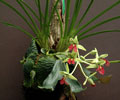|
|
|
|
 |
Email Address Recovery or Password Reset |
Use our Change Password page, and you can set a new password, or if you don't remember which email address you
registered with, the same page may be able to suggest it based on another you enter.
|
|
|
|
|
| |
Flasks of
Cymbidiella pardalina 'Hopbrook' × self |
|
| |
|
|
| |
|
|
Click to Enlarge

Pod Parent Flower |
Click to Enlarge

Pod Parent Blooming Plant |
Click to Enlarge

Cymbidiella pardalina & Platycerium madagascariense |
Click to Enlarge

Pod Parent Blooming Plant |
|
|
|
| |
Culture Notes from Donor: Parent plant: Temperature range I (60-83°F). Will look best mounted... and even better if you can find its naturally occurring symbiont Platycerium madagascariense ...and pair them up as shown in the photo. Otherwise select a wood basket when big enough. Till then, avoid any root disturbance. Even mature plants with many backbulbs have been killed by injury to roots or rhizome. Resist dividing.
Comments: Parent plant: Large plant.
For additional origin/habitat information supplied courtesy of
Charles and Margaret Baker, see further below, near the bottom of this page.
|
Temperatures we attempt to use in the lab & greenhouse:
| For Species: |
|
Spring, Summer, Autumn: days average 78°F, nights 66°F; best fit is Intermediate 83-60°F
(Source:
Baker's Web OSC) |
| For Species: |
|
Winter: days average 68°F, nights 57°F; best fit is Cool 70-52°F
(Source:
Baker's Web OSC) |
|
About the name...
| Etymology of |
Cymbidiella |
|
From latinized Greek "Cymbidiella" ella = diminuitive; like a small Cymbidium.
(Source:
Mayr & Schmucker 1998) |
| Etymology of |
pardalina |
|
From Latin "pardalinus" parsimonious, insignificant.
(Source:
Mayr & Schmucker 1998) |
| Pronunciation of |
Cymbidiella |
|
sim-big-ee-EL-uh
(Source:
http://davesgarden.com/nl.php?date=2003-04-15) |
|
If you would like to direct someone to this web page, please copy and paste this URL into your email:
http://troymeyers.com/d?016109
| Flask Information |
| Availability: |
We have sold all of the flasks for this item. |
| You should: |
Consider getting individual plants or compots instead of a flask.
You can place a "Notify Flask Recipients" Request, and either we or a flask recipient may contact you when plants are available.
You may also place a "Notify Retries" Request, and if an identical pollination (the same parents) is done again, we'll let you know.
You may reserve a flask, but it's very unlikely you'll get one ...this could only happen if we found a flask that we didn't know we had. |
| Yield Estimate: |
20 plants (based on flask surveys done 02/25/2009 )
|
| Plantlet Sizes: |
From many flasks 40 - 90 mm plants (based on flask surveys done 06/22/2009 )
From one most recently surveyed flask 40 - 90 mm (06/22/2009)
|
|
You might also want to:
|
View the seed assay for this item.
View items of the same species.
View items of the same genus.
|
| Ordering Information |
| You are not currently logged in. |
|
You must be a registered user and be logged in to reserve a flask or place a notification request. Please log in:
|
|
 |
Email Address Recovery or Password Reset |
Use our Change Password page, and you can set a new password, or if you don't remember which email address you
registered with, the same page may be able to suggest it based on another you enter.
|
|
|
|
|
|
|
|
| |
The origin/habitat information below is supplied courtesy of Charles and Margaret Baker
The following information is based on the name of the plant provided by the donor, and assumes that the name is correct. If the plant has been misidentified, then the following information may not be correct.
This text is copyrighted by the Bakers and may not be reproduced without permission.
ORIGIN/HABITAT: Madagascar. Plants grow on trees in the forests of the
eastern part of the island at 1950-2600 ft. (600-800 m). In the wild, they
almost always grow in association with the fern, Platycerium
madagascariense.
More about this information and the Bakers...
|
|
|
| |
|
|
|